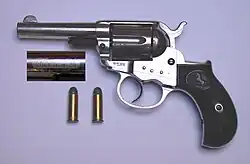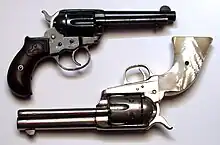Colt M1877
The Colt M1877 was a double-action revolver manufactured by Colt's Patent Fire Arms from January 1877 until 1909 for a total of 166,849 revolvers. The Model 1877 was offered in three calibers, which lent them three unofficial names: the "Thunderer", the "Lightning", and the "Rainmaker". The principal difference between the models was the cartridge in which they were chambered for, these are the "Thunderer" in .41 Long Colt; the "Lightning" in .38 Long Colt; and the "Rainmaker" in .32 Long Colt. All of the models had a six-round capacity.[1][2]
| Colt M1877 | |
|---|---|
 Colt M1877 "Lightning" | |
| Type | Revolver |
| Place of origin | United States |
| Production history | |
| Designer | William Mason |
| Designed | 1877 |
| Produced | 1877–1909 |
| No. built | 166,849 |
| Specifications | |
| Cartridge | .32 Long Colt ("Rainmaker") .38 Long Colt ("Lightning") .41 Long Colt ("Thunderer") |
| Action | double-action revolver |
| Feed system | 6-shot cylinder |

History
The M1877 was designed by one of the inventors of the Colt Single Action Army (M1873), William Mason, as Colt's first attempt at manufacturing a double-action revolver. It was the first successful US-made double-action cartridge revolver,[2] and was offered from the factory in two basic finishes: nickel-plated or a blued with a case-colored frame. The revolver was available in barrel lengths from 2+1⁄2 to 7+1⁄2 inches and with or without the ejector rod and housing. The shorter-barreled versions without the ejector rod were marketed as "shopkeeper's specials" for use as a concealable pocket pistol.[1]
Neither of the names, "Lightning" or "Thunderer" were Colt designations, nor used by the factory in any reference materials. Both terms were coined by Benjamin Kittredge, one of Colt's major distributors. Kittredge was responsible for the terms "Peacemaker" for the Single Action Army, "Omnipotent" for the Colt M1878 double-action (often known as the "Frontier" model), and nicknames for the various chamberings of the New Line models.[3]
The M1877's early double-action mechanism proved to be both intricate and delicate, thus it was vulnerable to failure of self cocking. The design had a garnered a negative reputation and earned the nickname "the gunsmith's favorite". Because of the intricate design and difficulty of repair, gunsmiths to this day dislike working on them.[2] Gun Digest referred to it as "the worst double-action trigger mechanism ever made".[4] Typically, the trigger spring would fail and this would reduce the revolver to single-action fire only. Outwardly, the Model 1877 shows a striking resemblance to the Colt Single Action Army revolver, however, it is scaled down slightly and much smaller in dimension. The bird's head grips were of checkered rosewood on the early guns and hard rubber on the majority of later-production guns.[4]
The "Lightning" was the favored personal weapon of famous Manchester (United Kingdom) Victorian detective, and then head of CID, Jerome Caminada. Old West outlaw John Wesley Hardin frequently used both "Lightning" and "Thunderer" versions,[2] and the "Thunderer" was the preferred weapon of Billy the Kid, even carried by him when he was killed by Pat Garrett in 1881.[5][6][7] Doc Holliday was also known to carry a nickel-plated "Thunderer" in his waistband as an accompanying gun to his nickel-plated Colt Single Action Army. Both revolvers had ivory or pearl grips.
In popular culture
The song "41 Thunderer" by Dave Carter and Tracy Grammer is a reference to the 1877 Colt Thunderer revolver chambered in the .41 Long Colt cartridge.
References
- Flayderman, Norm (2001). Flayderman's Guide to Antique American Firearms... and their values. Iola, WI: Krause Publications. p. 669. ISBN 0-87349-313-3.
- Herring, Hal (2008). Famous Firearms of the Old West: From Wild Bill Hickok's Colt Revolvers to Geronimo's Winchester, Twelve Guns That Shaped Our History. TwoDot. p. 224. ISBN 978-0-7627-4508-1.
- Gurr, Ted Robert (1979). Violence in America: The History of Crime. SAGE. p. 145. ISBN 978-0-8039-3228-9. Retrieved 13 July 2012.
- Wood, JB (2001). The Gun Digest Book of Firearms Assembly/Disassembly: Revolvers. Iola, WI: Krause Publications. p. 576. ISBN 978-0-87341-923-9.
- Boorman, Dean K. (2004). Guns of the Old West: An Illustrated History. Lyons Press. p. 128. ISBN 978-1-59228-638-6.
- Wilson, RL (1992). Peacemakers: Arms and Adventure in the American West. Edison, New Jersey: Chartwell Publications. p. 392. ISBN 978-0-7858-1892-2.
- Kinard, Jeff (2004). "The Metallic Cartridge and the Modern Revolver". Pistols: An Illustrated History of Their Impact. Weapons and warfare series. ABC-CLIO. p. 163. ISBN 978-1-85109-470-7.